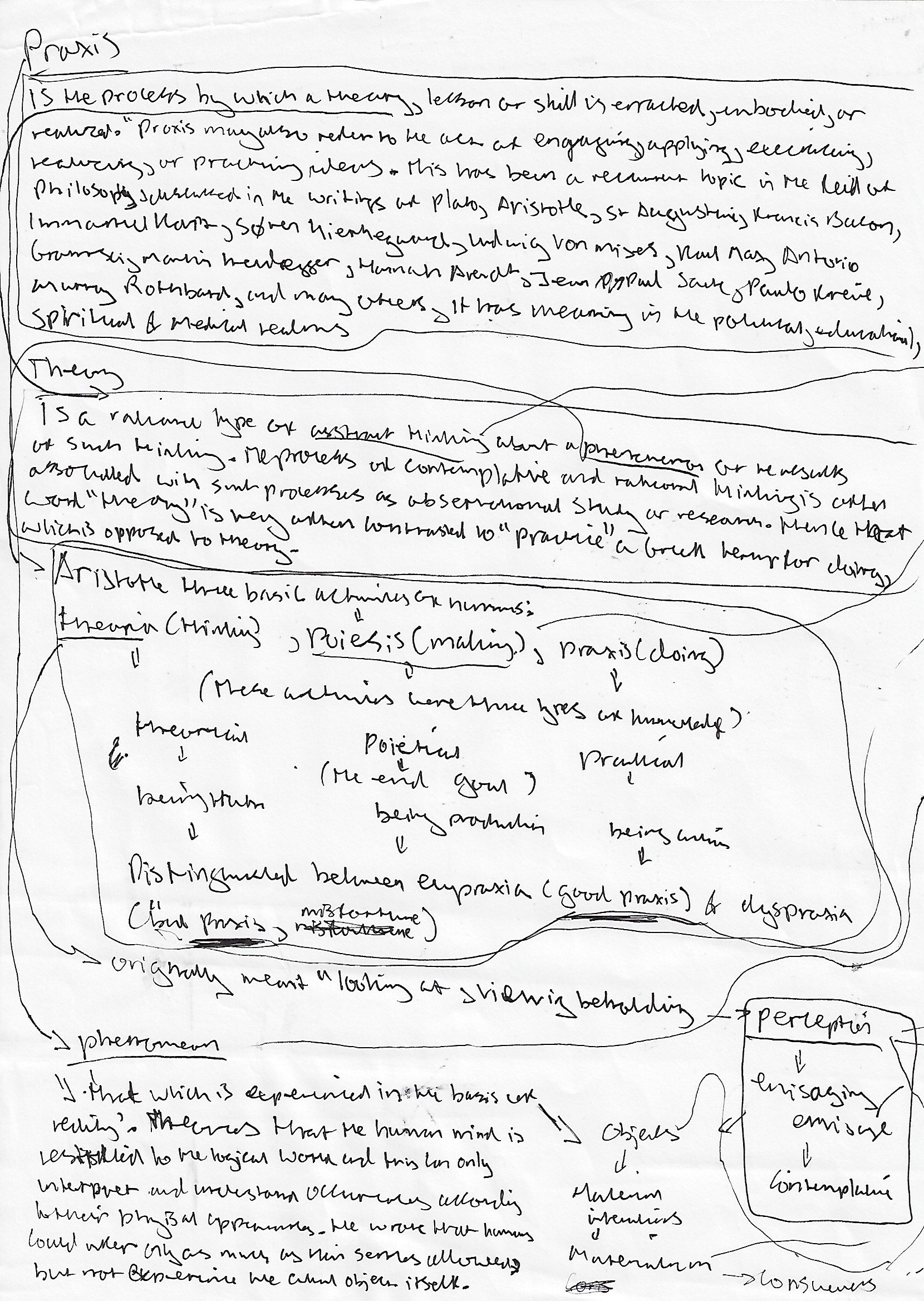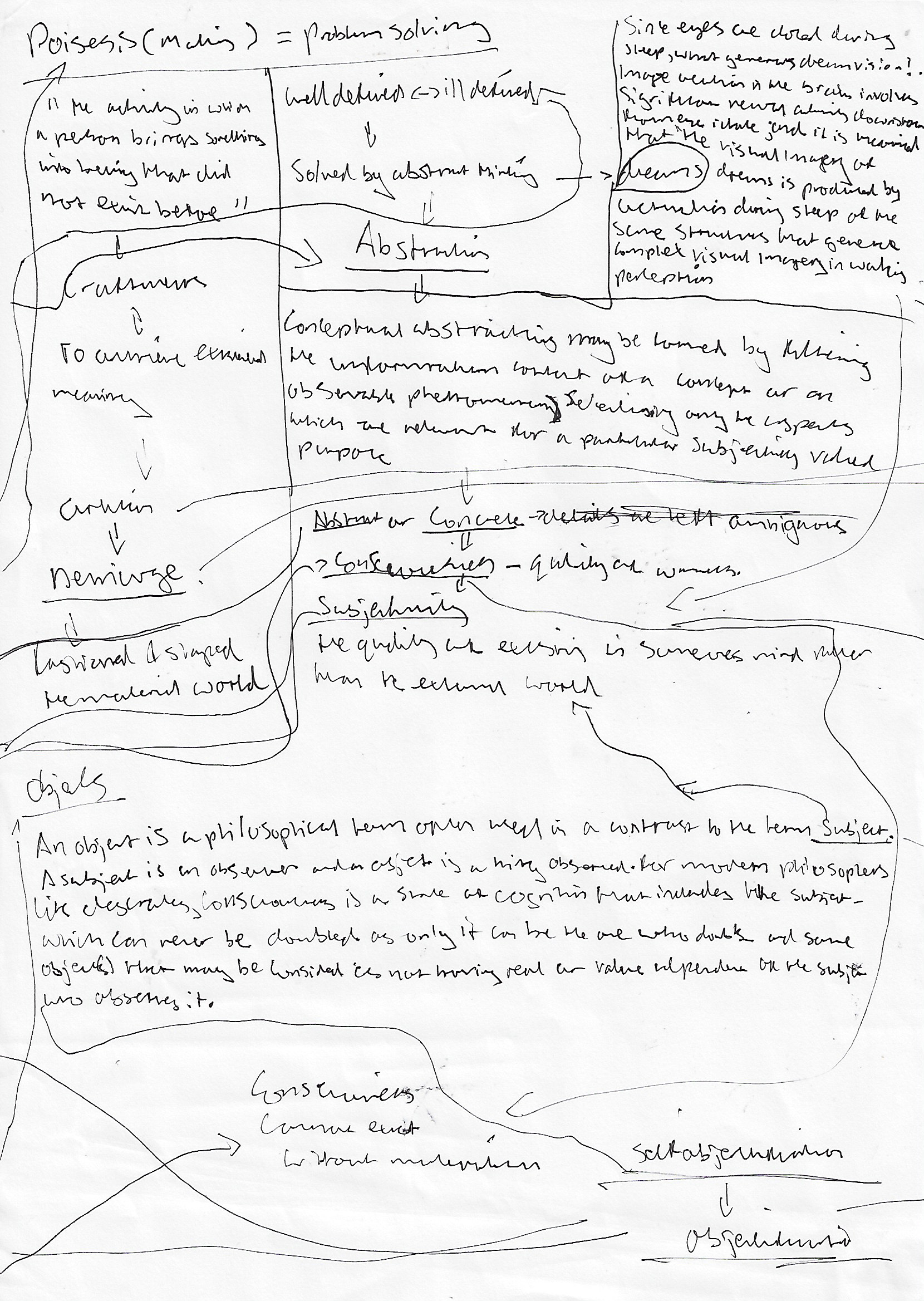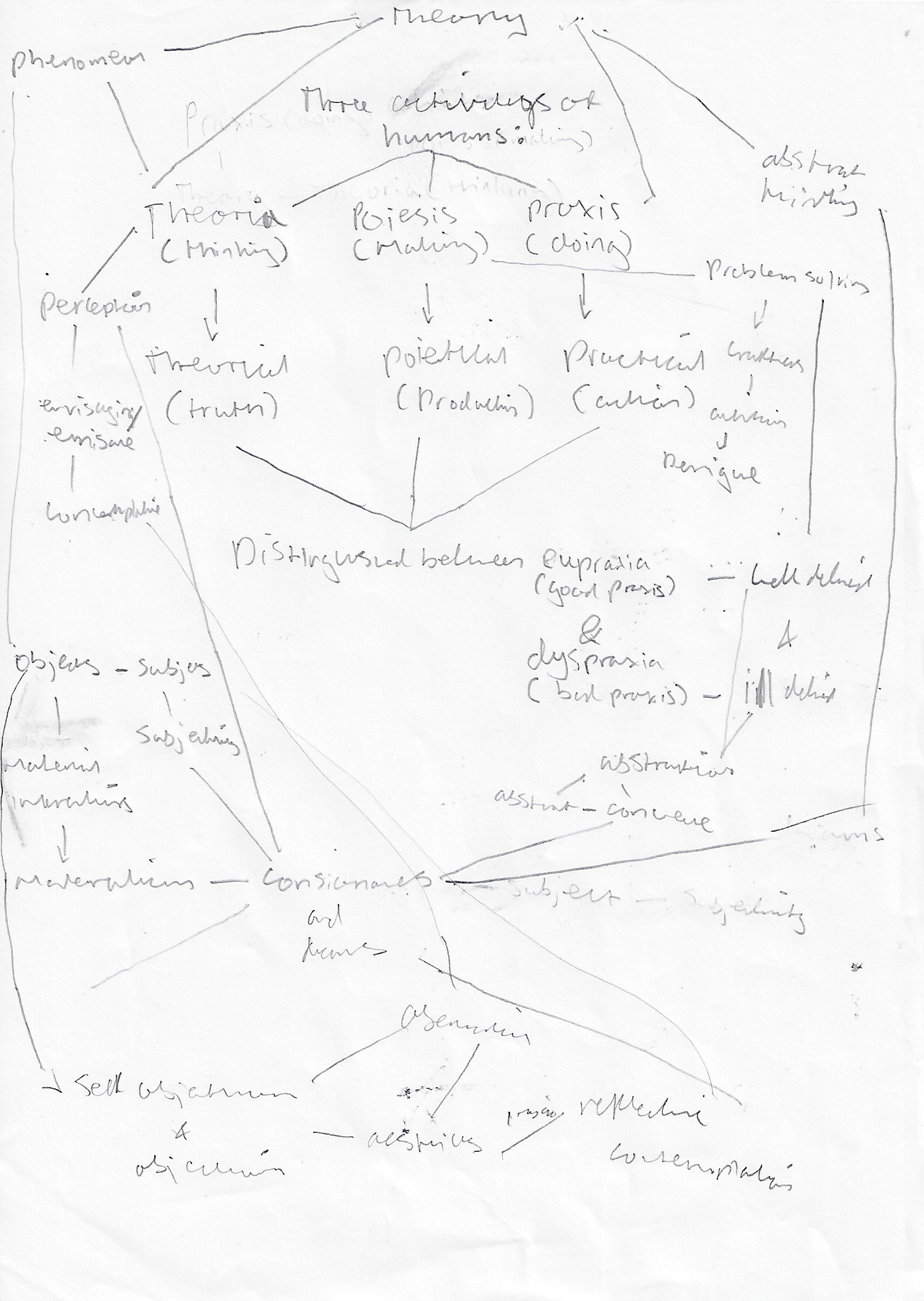Why is praxis...praxis?
Introduction




According to Aristotle, the three necessary activities in which humans are capable are theoria (thinking), poiesis (making) and praxis (doing). If you were to participate in these activities then you would gain knowledge dependent on each one. Theoria would become theoretical meaning obtaining knowledge by finding the truth in what you are thinking. Poiesis would become poietical, which involves turning the making behaviour (as in experimentation) into production (manufacturing). Lastly, praxis becomes practical. Thus it is opposed to the theoretical since its purpose is relying on proven knowledge and fact. Not theories/theory or ideas, hence practical relates to experience rather than imagining new solutions yet proven.
Aristotle also stated that the three types of knowledge can be compared by eupraxia (good praxis) and dyspraxia (bad praxis). Only once the task in which the knowledge is involved is completed. Praxis is the most crucial of the three knowledges because of the following. It can acknowledge right or wrong since it is more in tune with the real world. Meaning it can ''question the underlying assumptions of common sense in order to replace them, where necessary, with better-founded, or more comprehensive explanations'' (Burgin, 1986, p.141). Assumptions are without proof therefore common sense can be misguided by theoretical or poietical beliefs, affecting sound judgement. Therefore praxis is a needed activity to ensure decisions are made with correct assumptions. It should be noted that although praxis means doing it can also mean process.
Process is an activity with an eventual ending. The activity will always need knowledge which I have already described. Yet what is before knowledge is as important to the process.
''It dwells somehow ''inside'' the body, but it is ultimately detachable from this body-housing... to remind us of the sense of eeriness intrinsic to our unstable accounts of subject and object. Mind and body'' (Fisher, 2016, p.108).
Eeriness intrinsic, a natural emotion to what is strange and unknown to the individual when they the subject can't fabricate a sense of knowing when an object is foreign to their understanding of what ''might involve forms of knowledge, subjectivity and sensation that lies beyond common experience'' (Fisher, 2016, p.62). Hence the subject (the mind) may draw upon consciousness rational to aid in its understanding of unknowingness (before knowledge) by focusing on what is not part of their visual plane. Hence ''It'' may refer to dreams because dreams materialize our experiences which are beyond ordinary in terms of what we decide fits and does not into the physical world. Therefore dreams & consciousness play a pivotal part in how we participate in the process of anything and everything. I will now go on to explain this further.
Eupraxia and dyspraxia can be compared to two separate dualisms. The first is well defined & ill-defined. Meaning is the process described clearly so that it is understandable, or has it become a mess that is lacking thus unclear. The second is abstract and concrete. These two are more to do with how the process is presented. Abstract refers to a conceptual feeling that can't be proven whereas in concrete we know that it is a true feeling due to our senses telling us so. Both dualisms are separate aspects of abstraction (in regard to process). Abstraction is when key characteristics are displayed only so that the outcome is presented to support attributes that can be understood or relevant. The difference between the two dualisms is simple. Well, and ill-defined has more in common with the term problem-solving. The reason being problem-solving is reducing the complexity by trying different methods that have specific outlines. Therefore, boundaries which furthermore is definite, hence defined. Abstract and concrete directly relate to dream and consciousness. An abstract is imaginative and thus not limited to the physical scope of observation such as dreams. Concrete is a real sense of knowing and that is directed from the conscious mind due to storing the past experiences of our senses.
Yet the link between praxis and dreams and consciousness is more complex. Problem-solving is necessary within any process/praxis. It determines the outcome. There is always more than one solution that is considered. The solutions are vast in size in terms of attributes needed to solidify before testing. Theoretically the same can be said for how it fits within this introduction.
A craftsman, a person who has trained to become knowledgeable in a certain area of trade. By being able to problem solve quickly to create a living for themself. Or the said person is trained to make decorative pieces that are labelled as art. Therefore, a craftsman and be called an artisan depending on their trade. Both titles link back to Poiesis (making). Poiesis is all about creating a form that can refer to anything brought into existence by being made. An artisan can be confused with a fashioner. The difference is the following an artisan is skilled in their work to the point where they know when a piece is being ethical. Whereas a fashioner is more concerned with forming a shape required for anything that needs to be covered. Hence ethical values are not prioritised since they may hinder the process. Both titles are given to two separate god/creator like figures in various beliefs. Demigure, creator of the universe the being who shaped the material world is considered an artisan. Morpheus meaning fashioner from the greek word shape/foam is one of the dream shapes (sons of the Roman god Somnus). The material world is what we view as physical hence it can influence consciousness. By being aware makes us prone to developing attitudes or emotions, caused by senses which emit the world. Lastly, Morpheus is referred to as the lord of dreams.
Problem-solving can be difficult at times when the outcome is not clear. Abstract thinking is used to aid in finding the solution. Abstract thinking is a creative process where conceptuality is key to understanding a wider picture (concept) that draws from physical experiences and imaginative foresight. Although abstract thinking ties in with problem-solving, therefore Poiesis. It may have a stronger relationship with theoria (thinking). Using abstract thinking to solve a problem could generate a theory. This means that a group of ideas joined together to explain something that is not explainable by itself until proven. Accordingly, then, itself is a phenomenon. This implies something which is observed but questioned on why it appears as such when observed. Therefore, it exists but why does it happen to exist. Furthermore, something (the problem) can be described as an object. Thus, the person who is solving is the subject observing the object. Yet the subject does more than just observe.
''The brain is part of the material world; the material world is not part of the brain'' (Bergson, 2004, p.4). This means when in reflective thought the material world will still affect the way we think even when we do not acknowledge what is around us. While deep in thought about an object the brain will still be stimulated which could affect the way we observe it. This is done firstly by perception. Meaning experiencing the world by stimuli. Next is forming a mental image, which is envisaging. Last is contemplation. This is where being in a state of thought for a considerate amount of time will eventually conclude with the object no longer being questioned. The subject, however, is prone to natural subjectivity. Causing the object to become aesthetically judge, which would mean that the brain may have been influenced by experiences that are correlated between dreams and consciousness. The reason for this is that:
''There is no perception which is not full of memories. With the immediate and present data of our senses, we mingle a thousand details out of our past experience. In most cases these memories supplant our actual perceptions, of which we then retain only a few hints, thus using them merely as 'signs' that recall to us former images'' (Bergson, 2004, p.24)
Hence subjectivity still happens while we are dreaming or attempting to fall asleep. The brain processes information all the time. When at our most relaxed state memories may resurface like having a sudden thought when thinking over something for a long time or in other words our perception of something can suddenly change when you are aware of its presence in your consciousness.
Bibliography
Fisher, M. (2016) The weird and the eerie. London: Repeater books
Miller, D. (2005) Materiality. North Carolina: Duke University Press
Burgin, V. (1986) End of art theory. London: Macmillan
Bergson, H. (2004) Matter and memory. Mineola, N.Y: Dover publications
Bohm, D., & Nichol, L. (2004). On creativity ([New ed.] / with a new preface by Leroy Little Bear /edited by Lee Nichol.). New York: Routledge.